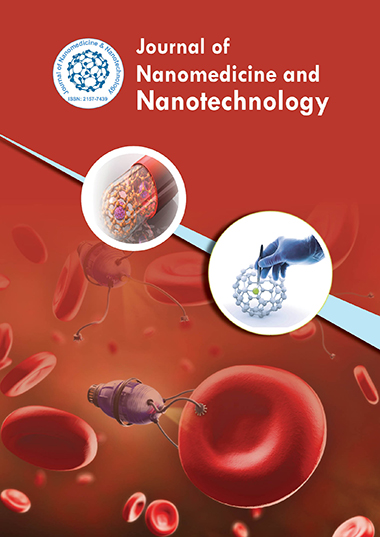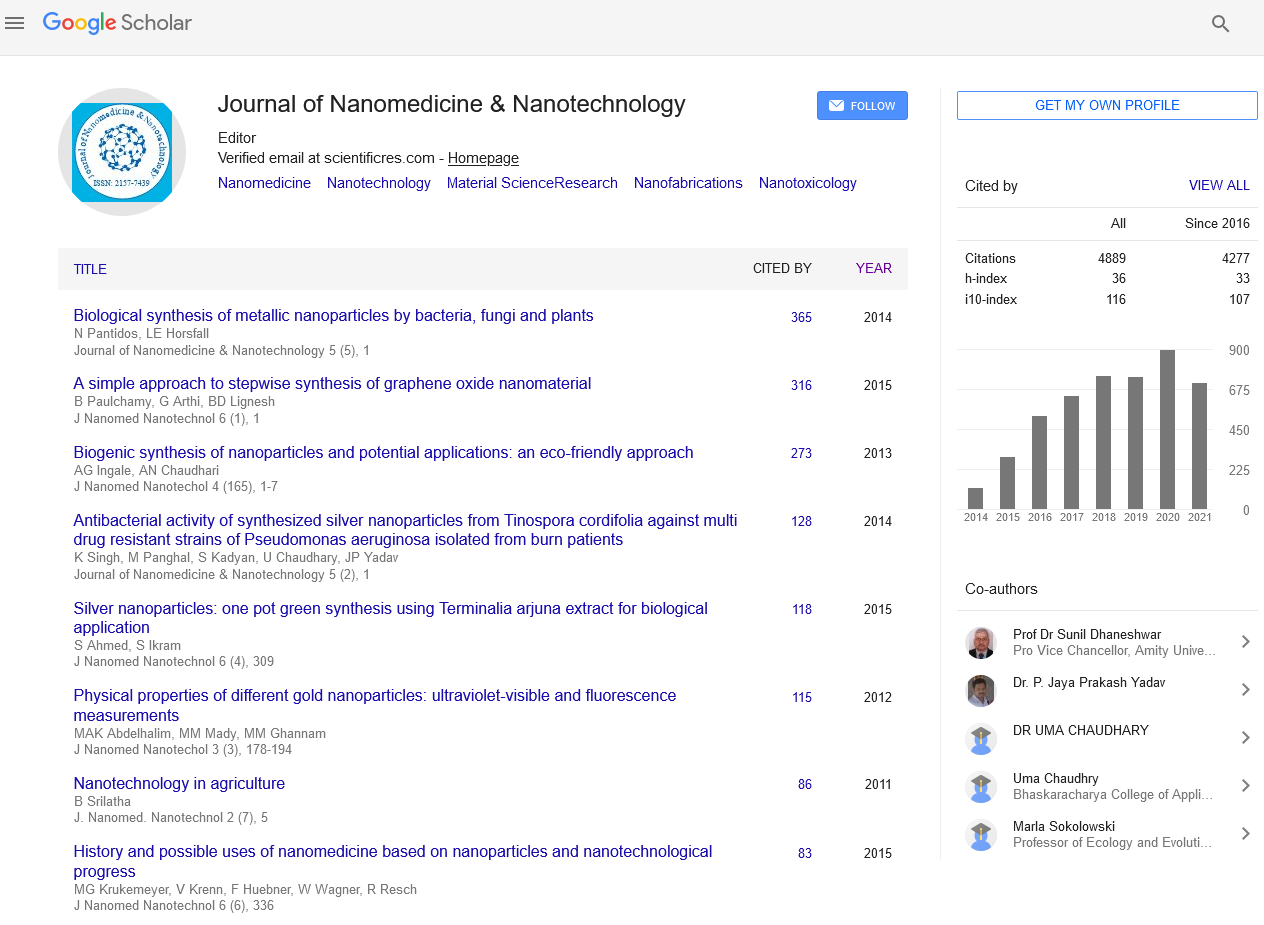Indexed In
- Open J Gate
- Genamics JournalSeek
- Academic Keys
- JournalTOCs
- ResearchBible
- China National Knowledge Infrastructure (CNKI)
- Scimago
- Ulrich's Periodicals Directory
- Electronic Journals Library
- RefSeek
- Hamdard University
- EBSCO A-Z
- OCLC- WorldCat
- SWB online catalog
- Virtual Library of Biology (vifabio)
- Publons
- MIAR
- Scientific Indexing Services (SIS)
- Euro Pub
- Google Scholar
Useful Links
Share This Page
Journal Flyer

Open Access Journals
- Agri and Aquaculture
- Biochemistry
- Bioinformatics & Systems Biology
- Business & Management
- Chemistry
- Clinical Sciences
- Engineering
- Food & Nutrition
- General Science
- Genetics & Molecular Biology
- Immunology & Microbiology
- Medical Sciences
- Neuroscience & Psychology
- Nursing & Health Care
- Pharmaceutical Sciences
Editorial - (2024) Volume 15, Issue 6
Quantum Dot-Based Imaging and Biosensing for Early Detection of Neurodegenerative Diseases
Lachlan Muir*Received: 02-Nov-2024, Manuscript No. jnmnt-24-28304 ; Editor assigned: 05-Nov-2024, Pre QC No. jnmnt-24-28304 (PQ); Reviewed: 20-Nov-2024, QC No. jnmnt-24-28304 ; Revised: 25-Nov-2024, Manuscript No. jnmnt-24-28304 (R); Published: 30-Nov-2024, DOI: 10.35248/2157-7439.24.15.766
Abstract
Neurodegenerative diseases, including Alzheimer's disease (AD), Parkinson's disease (PD), and Huntington's disease (HD), represent a growing challenge for modern medicine, with early diagnosis playing a crucial role in effective treatment and management. Quantum dots (QDs), semiconductor nanocrystals with unique optical properties, have emerged as powerful tools in imaging and biosensing applications due to their high brightness, photostability, and tunable emission spectra. In particular, QD-based imaging techniques hold significant promise for early detection of neurodegenerative diseases by enabling high-resolution imaging of cellular and molecular processes at the early stages of disease progression. Additionally, QDs can be functionalized with biomolecules such as antibodies or peptides for the specific targeting of biomarkers associated with these diseases, facilitating highly sensitive and selective detection. This review explores the advancements in QD-based imaging and biosensing strategies for the early detection of neurodegenerative diseases, focusing on their application in biomarker detection, imaging of brain tissue, and potential for non-invasive diagnostics. The challenges, limitations, and future directions for QD-based technologies in the context of neurodegenerative diseases are also discussed
Keywords
Quantum dots; Imaging, biosensing; Neurodegenerative diseases; Alzheimer's disease; Parkinson's disease;
biomarkers; Early detection; Non-invasive diagnostics
INTRODUCTION
Neurodegenerative diseases, including Alzheimer’s disease (AD), Parkinson’s disease (PD), and other forms of dementia, are characterized by the progressive degeneration of neurons in the brain, often leading to cognitive decline, motor dysfunction, and ultimately death. Early detection of these diseases is critical for timely intervention and improving patient outcomes. However, current diagnostic methods, such as MRI, PET, and CSF biomarker analysis, often do not detect these diseases at their earliest stages. There is an urgent need for more sensitive and reliable diagnostic tools that can detect these diseases at a molecular level, potentially before significant neuronal damage occurs [1]. Quantum dots (QDs), which are semiconductor nanocrystals, have gained significant attention in the fields of imaging and biosensing due to their remarkable optical properties. Unlike traditional organic dyes, QDs exhibit high photostability, narrow emission spectra, and tunable fluorescence, making them ideal for various biomedical applications, including bioimaging and disease detection. In the context of neurodegenerative diseases, QD-based platforms offer the potential for non-invasive, real-time imaging of disease biomarkers and monitoring of disease progression. This review discusses the role of QD-based imaging and biosensing in the early detection of neurodegenerative diseases, focusing on their application in biomarker detection, brain tissue imaging, and diagnostic innovations [2].
QUANTUM DOTS IN EARLY DETECTION OF NEURODEGENERATIVE DISEASES
Quantum Dots as Biomarker Probes
The early diagnosis of neurodegenerative diseases depends on the identification of specific biomarkers that are present in the cerebrospinal fluid (CSF), blood, or directly within the brain tissue. Quantum dots can be functionalized with various targeting ligands such as antibodies, peptides, or aptamers, which allow for highly specific recognition of disease-related biomarkers. In Alzheimer’s disease, for example, QDs have been employed to detect amyloid-beta plaques and tau tangles, which are hallmark biomarkers of the disease. Similarly, in Parkinson's disease, QDs can be used to detect alpha-synuclein aggregates, which are associated with the onset and progression of the disease.
Targeted Detection of Specific Proteins and Peptides
One of the key advantages of QD-based biosensors is their ability to specifically target and bind to protein aggregates or other disease-specific molecules. Functionalizing QDs with antibodies that recognize specific neurodegenerative disease biomarkers, such as amyloid-beta or tau, allows for the direct visualization and quantification of these molecules in biological samples. The surface of QDs can be modified to bind to the amyloid fibrils, and their fluorescence can be used to monitor the interaction in real time, offering a tool for early detection before extensive plaque deposition occurs. Similarly, the detection of alpha-synuclein aggregates in Parkinson’s disease using QD-conjugated antibodies provides a sensitive method for identifying disease onset [3].
Multiplexed Detection
Another key advantage of QDs is their ability to simultaneously detect multiple biomarkers due to their distinct emission spectra. This property enables the simultaneous analysis of multiple biomarkers for different neurodegenerative diseases in a single test. By using QDs with different sizes and compositions, it is possible to multiplex the detection of several disease-related proteins or aggregates, enabling a more comprehensive view of disease progression. For example, QDs can be functionalized to detect both amyloid-beta and tau in Alzheimer’s disease or alpha-synuclein and neurofilament light chain in Parkinson's disease.
QUANTUM DOT-BASED IMAGING FOR EARLY DETECTION
In Vivo Brain Imaging
The ability to visualize molecular processes in living organisms is crucial for early diagnosis and monitoring of neurodegenerative diseases. Quantum dots are particularly suited for in vivo imaging due to their photostability and bright fluorescence. When conjugated with targeting ligands, QDs can be used to label specific biomarkers in living models of neurodegenerative diseases. The use of QDs in fluorescence imaging allows for real-time monitoring of biomarker accumulation in tissues, providing valuable insights into the progression of diseases such as Alzheimer’s and Parkinson’s. Additionally, QDs can be used in combination with advanced imaging techniques such as multiphoton microscopy and confocal microscopy to achieve high-resolution images of the brain at the cellular level [4].
Neuroimaging with Quantum Dots
Quantum dots also hold promise for imaging neurodegenerative diseases at the molecular level, such as the identification of amyloid-beta plaques in Alzheimer’s disease and Lewy bodies in Parkinson’s disease. In combination with imaging modalities like magnetic resonance imaging (MRI) or positron emission tomography (PET), QDs can serve as a contrast agent that enhances the visibility of specific biomarkers. This dual-imaging approach enables the detection of these biomarkers with higher sensitivity, providing an accurate and early diagnosis of neurodegenerative diseases.
QUANTUM DOTS IN BIOSENSING
Fluorescent Biosensors for Biomarker Detection
Quantum dots are widely used in biosensors due to their ability to generate highly stable and bright fluorescence signals upon exposure to light. These properties make QDs an excellent choice for developing biosensors to detect specific molecular markers in biofluids such as blood, saliva, or cerebrospinal fluid. When QDs are conjugated with specific antibodies or other targeting ligands, they can selectively bind to the biomarker of interest. Upon binding, the QDs emit fluorescence that can be detected and quantified, providing valuable information for early diagnosis. This method offers a more sensitive alternative to traditional methods like enzyme-linked immunosorbent assays (ELISA) and Western blotting [5].
Non-invasive Biosensing for Early Diagnosis
Non-invasive detection of neurodegenerative diseases is a major goal in modern medicine. QD-based biosensors have the potential to provide a non-invasive, real-time diagnostic platform. By detecting biomarkers present in easily accessible biological fluids such as blood or urine, QD-based sensors can offer a convenient and cost-effective alternative to traditional diagnostic methods. These sensors can be integrated into wearable devices or portable diagnostic systems, making them suitable for point-of-care diagnostics [6].
CHALLENGES AND LIMITATIONS
While QD-based imaging and biosensing platforms show great promise for the early detection of neurodegenerative diseases, there are several challenges that must be addressed
Toxicity and Biocompatibility: The potential toxicity of quantum dots, particularly those containing heavy metals such as cadmium, remains a significant concern. Although surface coatings can mitigate some of these issues, further research is needed to ensure that QDs are biocompatible and do not induce long-term toxicity or immune responses [7].
Scalability and Cost: The synthesis of quantum dots with high purity and uniformity is still a complex and expensive process. To make QD-based diagnostics widely accessible, scalable production methods and cost-effective manufacturing processes need to be developed [8].
Clinical Translation: Despite their success in preclinical models, the translation of QD-based diagnostics into clinical settings remains a challenge. This includes regulatory approval, large-scale validation, and the development of standardized protocols for QD-based diagnostic assays [9].
FUTURE DIRECTIONS
Future research will focus on improving the biocompatibility, stability, and scalability of quantum dots for use in clinical applications. The development of biocompatible coatings and green synthesis methods for QDs will enhance their safety profile. Additionally, advances in multiplexed detection and functionalization strategies will improve the ability of QD-based platforms to detect multiple biomarkers simultaneously, enhancing diagnostic capabilities. Combining QD-based diagnostics with emerging technologies such as CRISPR-based biosensing and lab-on-a-chip devices will also open new avenues for point-of-care applications [10].
CONCLUSION
Quantum dot-based imaging and biosensing offer significant potential for the early detection of neurodegenerative diseases. The unique optical properties of quantum dots, combined with their ability to be functionalized for targeted biomarker detection, provide a powerful tool for non-invasive, real-time diagnostics. Despite challenges such as toxicity and scalability, ongoing advancements in nanotechnology and surface chemistry are likely to overcome these hurdles, leading to the broader adoption of quantum dot-based platforms in clinical settings for the early diagnosis and monitoring of neurodegenerative diseases.
REFERENCES
- Villegas R, RamÃrez L, Guevara H, Sicairos P, Ayala H, Sanchez L. Synthesis and characterization of magnetite nanoparticles for photocatalysis of nitrobenzene. Journal of Saudi Chemical Society.2020;24(2): 223-235.
- Newbury E, Ritchie W. Is scanning electron microscopy/energy dispersive Xâ?ray spectrometry (SEM/EDS) quantitative? Scanning. 2013; 35(3):141-168.
- Pan Z, Lin Y, Sarkar B, Owens G, Chen Z. Green synthesis of iron nanoparticles using red peanut skin extract: Synthesis mechanism, characterization and effect of conditions on chromium removal. Journal of Colloid and Interface Science.2020; 558: 106-114.
- Qu S, Huang F, Yu S, Chen G, Kong J. Magnetic removal of dyes from aqueous solution using multi-walled carbon nanotubes filled with Fe2O3 particles. Journal of Hazardous Materials.2008; 160(2-3): 643-647.
- KaradeV, Waifalkar P, Dongle T, Sahoo S C, Kollu P, Patil P et al. Greener synthesis of magnetite nanoparticles using green tea extract and their magnetic properties. Mater Res Express.2017; 4(9): 096102.
- Li y, Jiang Y, Huang K. Ding P, Chen J. Preparation and properties of magnetic Fe3O4â??chitosan nanoparticles. Journal of alloys and compounds.2008; 466(1-2): 451-456.
- Poole C P, Owens F J. Introduction to nanotechnology. 2003.Â
- Fulekar M. Nanotechnology: importance and applications. IK International Pvt Ltd. 2010.
- Almomani F, Bhosale R, Khraisheh M, Almomani T. Heavy metal ions removal from industrial wastewater using magnetic nanoparticles (MNP). Appl Surf Sci.2020; 506: 144924.
- Zulfiqar N. Effect of adding surfactant additives (sodium lauryl sulphate) in water on the performance of flat plate solar distillation system for the purification of water. 2023.
Indexed at, Google Scholar, Crossref
Indexed at, Google Scholar, Crossref
Indexed at, Google Scholar, Crossref
Indexed at, Google Scholar, Crossref
Indexed at, Google Scholar, Crossref
Indexed at, Google Scholar, Crossref
Indexed at, Google Scholar, Crossref
Indexed at, Google Scholar, Crossref
Citation: Lachlan M (2024) Quantum Dot-Based Imaging and Biosensing for Early Detection of Neurodegenerative Diseases. J Nanomed Nanotech. 15: 766.
Copyright: ©2024 Lachlan M. This is an open-access article distributed under the terms of the Creative Commons Attribution License, which permits unrestricted use, distribution, and reproduction in any medium, provided the original author and source are credited


